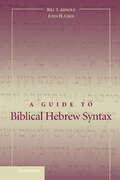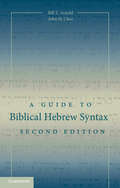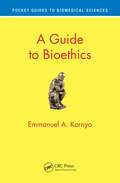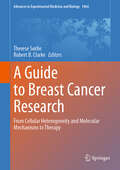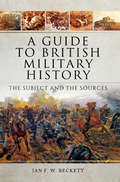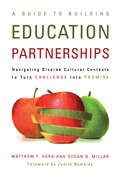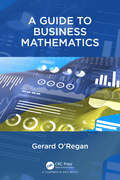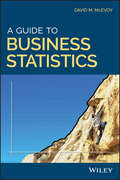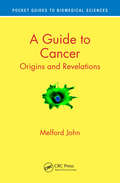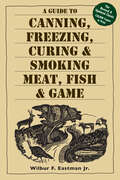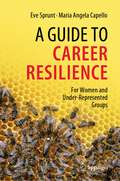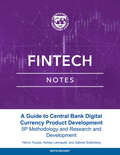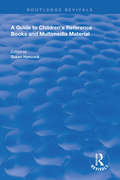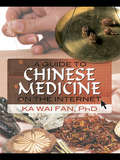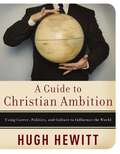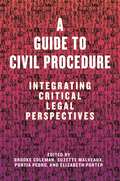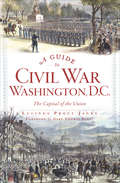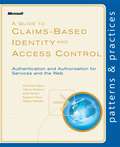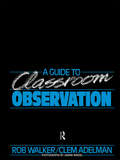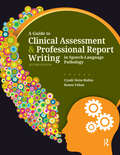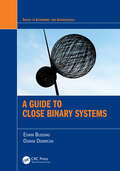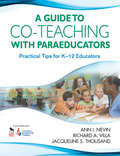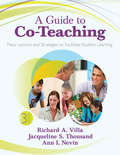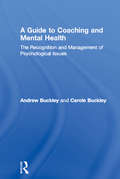- Table View
- List View
A Guide to Biblical Hebrew Syntax
by Bill T. Arnold John H. ChoiThis introduces and abridges the syntactical features of the original language of the Hebrew Bible or Old Testament. Scholars have made significant progress in recent decades in understanding Biblical Hebrew syntax. Yet intermediate readers seldom have access to this progress due to the technical jargon and sometimes-obscure locations of the scholarly publications. This Guide is an intermediate-level reference grammar for Biblical Hebrew. As such, it assumes an understanding of elementary phonology and morphology, and defines and illustrates the fundamental syntactical features of Biblical Hebrew that most intermediate-level readers struggle to master. The volume divides Biblical Hebrew syntax, and to a lesser extent morphology, into four parts. The first three cover the individual words (nouns, verbs, and particles) with the goal of helping the reader move from morphological and syntactical observations to meaning and significance. The fourth section moves beyond phase-level phenomena and considers the larger relationships of clauses and sentences.
A Guide to Biblical Hebrew Syntax
by Bill T. Arnold John H. ChoiA Guide to Biblical Hebrew Syntax introduces and abridges the syntactical features of the original language of the Hebrew Bible/Old Testament. An intermediate-level reference grammar for Biblical Hebrew, it assumes an understanding of elementary phonology and morphology, and it defines and illustrates the fundamental syntactical features of Biblical Hebrew that most intermediate-level readers struggle to master. The volume divides Biblical Hebrew syntax and morphology, into four parts. The first three cover the individual words (nouns, verbs, and particles) with the goal of helping the reader move from morphological and syntactical observations to meaning and significance. The fourth section moves beyond phrase-level phenomena and considers the larger relationships of clauses and sentences. Since publication of the First Edition, research on Biblical Hebrew syntax has substantially evolved. This new edition incorporates these developments through detailed descriptions of grammatical phenomena from a linguistics approach. It retains the labels and terminology used in the First Edition to maintain continuity with the majority of entry-level and more advanced grammars.
A Guide to Biblical Sites in Greece and Turkey
by Clyde E. Fant Mitchell G. ReddishIn A Guide to Biblical Sites in Greece and Turkey, two well-known, well-traveled biblical scholars offer a fascinating historical and archaeological guide to these sites. The authors reveal countless new insights into the biblical text while reliably guiding the traveler through every significant location mentioned in the Bible. The book completely traces the journeys of the Apostle Paul across Turkey (ancient Asia Minor), Greece, Cyprus, and all the islands of the Mediterranean. <p><p>A description of the location and history of each site is given, followed by an intriguing discussion of its biblical significance. Clearly written and in non-technical language, the work links the latest in biblical research with recent archaeological findings. A visit to the site is described, complete with easy-to-follow walking directions, indicating the major items of archaeological interest. Detailed site maps, historical charts, and maps of the regions are integrated into the text, and a glossary of terms is provided.
A Guide to Bioethics (Pocket Guides to Biomedical Sciences)
by Emmanuel A. KornyoSolving intractable biotechnological questions of evolution, medicine, and genetics is now easier due to methods permitting the rapid analysis of molecular sequence data. These advances have exposed ethical and policy concerns. How would genomic information be used and by whom? Should individuals be able to make decisions regarding their own genomic data? How accurate are these genetic tests and how should they be regulated? These and other ethical conundrums are the subject of this book. Bioethicists, biomedical policy experts and lawyers, physicians, nursing and allied health students as well as science educators will find this book helpful and engaging in exploring the complexities of modern evolutionary, genetic and biomedical data.
A Guide to Breast Cancer Research: From Cellular Heterogeneity and Molecular Mechanisms to Therapy (Advances in Experimental Medicine and Biology #1464)
by Robert B. Clarke Therese SørlieThe book presents key topics at the forefront in breast development and cancer research in chapters authored by leading scientists in the field. The chapters provide a basis for understanding major concepts, model systems, cells of origin and heterogeneity in human breast development and cancer. The book builds on this understanding to guide readers through the cellular and molecular basis of breast cancer and the most important signaling pathways. Finally, the book describes mechanisms of metastasis and cancer immunity, and treatment options and resistance to therapy. It is targeted at young scientists and early career researchers and provides an overview of current topics in breast cancer research. Each chapter includes key learning points, boxes and conclusions to highlight the most important information. This book will interest anyone who wants to learn about the main areas of breast cancer research and the most important recent advances.
A Guide to British Military History: The Subject and the Sources
by Ian F. BeckettWhat exactly is military history? Forty years ago it meant battles, campaigns, great commanders, drums and trumpets. It was largely the preserve of military professionals and was used to support national history and nationalism. Now, though, the study of war has been transformed by the war and society approach, by the examination of identity, memory and gender, and a less Euro-centric and more global perspective. Generally it is recognised that war and conflict must be integrated into the wider narrative of historical development, and this is why Ian Becketts research guide is such a useful tool for anyone working in this growing field. It introduces students to all the key debates, issues and resources. While European and global perspectives are not neglected, there is an emphasis on the British experience of war since 1500. This survey of British military history will be essential reading and reference for anyone who has a professional or amateur interest in the subject, and it will be a valuable introduction for newcomers to it.
A Guide to Building Education Partnerships: Navigating Diverse Cultural Contexts to Turn Challenge into Promise
by Matthew T. Hora Susan B. MillarEducation partnerships are central to – and often a requirement of – most education reform initiatives promoted by state and local governments, by foundations, and by business funders. Many fail for failure to understand the dynamics of their complex relationships.This book provides insights and guidance to enable prospective and existing education partners to develop answers to the questions that are critical to success: Why engage in this partnership? How can you communicate the potential benefits of partnership to motivate teachers, faculty, administrators, and community members? How do you select the best organizational structure and procedures for a partnership? How can you maintain open, deliberative discussion while respecting different histories and cultures? How can you produce compelling evidence that the partnership is worthwhile? Based on their observation of a five-year-long publicly funded partnership, research data, and the literature, the authors identify the principles that they consider critical to answering these questions. The authors do not minimize the differences and complexities inherent in partnership work, because they believe that doing so would be to present coherence and homogeneity where none exists. Instead, they seek to make evident how these principles underlie many different partnership situations. Thus, rather than presenting a package of best practices, or a cookie-cutter approach, this book presents the organizational principles for planning and implementing education partnerships, along with sets of strategies for working through them. The authors present the diagnostic tools for undertaking a deliberate and research-based approach to planning, designing, and managing a partnership. By surfacing participants’ often-differing motivations, and the practices and assumptions they bring to the table, the book provides the foundation for developing a constructive relationship. In scope, the book extends beyond school-university partnerships to include schools’ collaboration with state and local governments, nonprofit organizations, and the business sector.
A Guide to Business Mathematics
by Gerard O'ReganThe success of business today is dependent on the knowledge and expertise of its employees. The need for mathematics arises naturally in business such as in the work of the actuary in an insurance company, the financial mathematics required in the day-to-day work of the banker and the need to analyse data to extract useful information to enable the business to make the right decisions to be successful. A Guide to Business Mathematics provides a valuable self-study guide to business practitioners, business students and the general reader to enable them to gain an appropriate insight into the mathematics used in business. This book offers an accessible introduction to essential mathematics for the business field. A wide selection of topics is discussed with the mathematical material presented in a reader-friendly way. The business context motivates the presentation. The author uses modelling and applications to motivate the material, demonstrating how mathematics is used in the financial sector. In addition to the role of the actuary and the banker, the book covers operations research including game theory, trade discounts and the fundamentals of statistics and probability. The book is also a guide to using metrics to manage and measure performance, and business economics. Foundations on algebra, number theory, sequences and series, matrix theory and calculus are included as is a complete chapter on using software. Features • Discusses simple interest and its application to promissory notes/treasury bills. • Discusses compound interest with applications to present and future values. • Introduces the banking field including loans, annuities and the spot/forward FX market. • Discusses trade discounts and markups/markdowns. • Introduces the insurance field and the role of the actuary. • Introduces the fields of data analytics and operations research. • Discusses business metrics and problem solving. • Introduces matrices and their applications. • Discusses calculus and its applications. • Discusses basic financial statements such as balance sheet, profit and loss and cash account. • Reviews a selection of software to support business mathematics. This broad-ranging text gives the reader a flavour of the applications of mathematics to the business field and stimulates further study in the subject. As such, it will be of great benefit to business students, while also capturing the interest of the more casual reader. About the Author Dr. Gerard O'Regan is an Assistant Professor in Mathematics at the University of Central Asia in Kyrgyzstan. His research interests include software quality and software process improvement, mathematical approaches to software quality, and the history of computing. He is the author of several books in the Mathematics and Computing fields.
A Guide to Business Statistics
by David M. McEvoyAn accessible text that explains fundamental concepts in business statistics that are often obscured by formulae and mathematical notation A Guide to Business Statistics offers a practical approach to statistics that covers the fundamental concepts in business and economics. The book maintains the level of rigor of a more conventional textbook in business statistics but uses a more streamlined and intuitive approach. In short, A Guide to Business Statistics provides clarity to the typical statistics textbook cluttered with notation and formulae. The author—an expert in the field—offers concise and straightforward explanations to the core principles and techniques in business statistics. The concepts are introduced through examples, and the text is designed to be accessible to readers with a variety of backgrounds. To enhance learning, most of the mathematical formulae and notation appears in technical appendices at the end of each chapter. This important resource: • Offers a comprehensive guide to understanding business statistics targeting business and economics students and professionals • Introduces the concepts and techniques through concise and intuitive examples • Focuses on understanding by moving distracting formulae and mathematical notation to appendices • Offers intuition, insights, humor, and practical advice for students of business statistics • Features coverage of sampling techniques, descriptive statistics, probability, sampling distributions, confidence intervals, hypothesis tests, and regression Written for undergraduate business students, business and economics majors, teachers, and practitioners, A Guide to Business Statistics offers an accessible guide to the key concepts and fundamental principles in statistics.DAVID M. McEVOY, PhD, is an Associate Professor in the Economics Department at Appalachian State University in Boone NC. He has published over 20 peer-reviewed articles and is coeditor of two books. Dr. McEvoy is an award-winning educator who has taught undergraduate courses in business statistics for over 10 years. DAVID M. McEVOY, PhD, is an Associate Professor in the Economics Department at Appalachian State University in Boone NC. He has published over 20 peer-reviewed articles and is coeditor of two books. Dr. McEvoy is an award-winning educator who has taught undergraduate courses in business statistics for over 10 years.An accessible text that explains fundamental concepts in business statistics that are often obscured by formulae and mathematical notation A Guide to Business Statistics offers a practical approach to statistics that covers the fundamental concepts in business and economics. The book maintains the level of rigor of a more conventional textbook in business statistics but uses a more streamlined and intuitive approach. In short, A Guide to Business Statistics provides clarity to the typical statistics textbook cluttered with notation and formulae. The author—an expert in the field—offers concise and straightforward explanations to the core principles and techniques in business statistics. The concepts are introduced through examples, and the text is designed to be accessible
A Guide to Cancer: Origins and Revelations (Pocket Guides to Biomedical Sciences)
by Melford JohnA Guide to Cancer: Origins and Revelations unfolds the complex and fascinating topic of cancer in two ways: firstly, no specialist knowledge is assumed on the part of the reader, and secondly, despite the serious nature of the topics, the book aims to stimulate interest, provoke thought, and paradoxically entertain. It takes an array of complex topics and breaks them down in clear, concise terms, so that anyone with a basic knowledge of science can understand. The book is aimed at the general public as well as students of biological subjects, first and second year university students, and researchers in the nascent field of cancer genomics.
A Guide to Canning, Freezing, Curing & Smoking Meat, Fish & Game
by Wilbur F. Eastman Jr.Preserve your meat properly and enjoy unparalleled flavor when you’re ready to eat it. This no-nonsense reference book covers all the major meat preserving techniques and how to best implement them. You’ll learn how to corn beef, pickle tripe, smoke sausage, cure turkey, and much more, all without using harsh chemicals. You’ll soon be frying up delicious homemade bacon for breakfast and packing your travel bag with tender jerky for snack time.
A Guide to Career Resilience: For Women and Under-Represented Groups
by Maria Angela Capello Eve SpruntMentors and sponsors are essential to career success, but these close relationships are not always free from trouble. This book shares advice and practical examples on how to survive and thrive throughout your career by differentiating between good and bad guidance you receive from mentors and sponsors. Real-life guidance is provided on how to manage troubled mentoring and sponsoring relationships at work.
A Guide to Central Bank Digital Currency Product Development (Fintech Notes Ser.)
by SoderbergA report from the International Monetary Fund.
A Guide to Children's Reference Books and Multimedia Material (Routledge Revivals)
by Susan HancockFirst published in 1998 , A Guide to Children’s Reference Books and Multi Material provides essential information on over 250 children’s reference products for parents, teachers and librarians wishing to purchase the best books and multimedia material in the late 90’s.
A Guide to Chinese Medicine on the Internet
by Ka Wai FanA Guide to Chinese Medicine on the Internet frees readers from having to sift through countless websites to find up-to-date, high quality, reliable information on all types of Chinese medicine. This handy resource provides an introduction to the terms and philosophies of Chinese medicine in addition to an extensive categorized listing of online sites related to Chinese culture and medicine, complete with a brief description of each site’s content. Guidelines are provided for searching, cataloging, and evaluating websites concerned with Chinese medicine, based on the author’s research and personal experience as a practitioner and user of Chinese medicines.
A Guide to Christian Ambition: Using Career, Politics, and Culture to Influence the World
by Hugh HewittHugh Hewitt has worked for and with people in some of the most powerful and influential positions in the country. He knows what is required to reach and thrive in such positions, and in this book he shares some of that valuable, hard-won knowledge.A Guide to Christian Ambition provides readers with valuable insights, wisdom, personal experiences, and advice on how to rise in the world and achieve the kind of radical success that honors God.
A Guide to Civil Procedure: Integrating Critical Legal Perspectives
by Brooke Coleman, et al.Shines a light on the ways in which civil procedure may privilege—or silence—voices in our justice systemIn today’s increasingly hostile political and cultural climate, law schools throughout the country are urgently seeking effective tools to address embedded inequality in the United States legal system. A Guide to Civil Procedure aims to serve as one such tool by centering questions of systemic injustice in the teaching, learning, and practice of civil procedure.Featuring an outstanding group of diverse scholars, the contributors illustrate how law school curriculums often ignore issues such as race, gender, disability, class, immigration status, and sexual orientation. Too often, students view the #MeToo movement, Black Lives Matter, immigration/citizenship controversy, or LGBTQ+ issues as mere footnotes to their legal education, often leading to the marginalization of many students and the production of graduates that do not view issues of systemic injustice as central to their profession.A Guide to Civil Procedure reveals how procedure is, and always has been, a central pressure point in the struggle to eradicate structural inequality and oppression through the courts. This book will give students and scholars alike a more complex view of their roles as attorneys, sharpen their litigation skills, and provide a stronger sense of community and purpose in the law school classroom.
A Guide to Civil War Washington, D.C.: The Capital of the Union (Civil War Ser.)
by Lucinda Prout JankeAn in-depth account of the Civil War people and events that left their mark on the city at the heart of the Union, shaping its historic legacy. When the first shots of the Civil War were fired in 1861, Washington, DC, was a small, essentially Southern city. The capital rapidly transformed as it prepared for invasion—army camps sprung up in Foggy Bottom, the Navy Yard on Anacostia was a beehive of activity, and even the Capitol was pressed into service as a barracks. Local citizens and government officials struggled to accommodate the fugitive slaves and troops that crowded into the city. From the story of one of the first African American army surgeons, Dr. Alexander Augusta to the tireless efforts of Clara Barton, historian Lucinda Prout Janke renders an intimate portrait of a community on the front lines of war. Join Janke as she guides readers through the changing landscape of a capital besieged. Includes photos!
A Guide to Claims-Based Identity and Access Control
by Dominick Baier Vittorio Bertocci Keith Brown Matias Woloski Eugenio PaceAs systems have become interconnected and more complicated, programmers needed ways to identify parties across multiple computers. One way to do this was for the parties that used applications on one computer to authenticate to the applications (and/or operating systems) that ran on the other computers. This mechanism is still widely used-for example, when logging on to a great number of Web sites. However, this approach becomes unmanageable when you have many co-operating systems (as is the case, for example, in the enterprise). Therefore, specialized services were invented that would register and authenticate users, and subsequently provide claims about them to interested applications. Some well-known examples are NTLM, Kerberos, Public Key Infrastructure (PKI), and the Security Assertion Markup Language (SAML). Most enterprise applications need some basic user security features. At a minimum, they need to authenticate their users, and many also need to authorize access to certain features so that only privileged users can get to them. Some apps must go further and audit what the user does. On Windows®, these features are built into the operating system and are usually quite easy to integrate into an application. By taking advantage of Windows integrated authentication, you don't have to invent your own authentication protocol or manage a user database. By using access control lists (ACLs), impersonation, and features such as groups, you can implement authorization with very little code. Indeed, this advice applies no matter which OS you are using. It's almost always a better idea to integrate closely with the security features in your OS rather than reinventing those features yourself. But what happens when you want to extend reach to users who don't happen to have Windows accounts? What about users who aren't running Windows at all? More and more applications need this type of reach, which seems to fly in the face of traditional advice. This book gives you enough information to evaluate claims-based identity as a possible option when you're planning a new application or making changes to an existing one. It is intended for any architect, developer, or information technology (IT) professional who designs, builds, or operates Web applications and services that require identity information about their users.
A Guide to Classroom Observation
by Clement Adelman Clem Adelman Roy WalkerFor many student teachers the classroom is a strange and potentially uncontrollable environment. This book shows how the period of classroom observation, which for most students precedes teaching practice, plays an important part in this transition process.
A Guide to Clinical Assessment and Professional Report Writing in Speech-Language Pathology
by Renee Fabus Cyndi Stein-RubinLearning to assess speech and language disorders and write diagnostic reports may be an overwhelming experience, especially when most texts don’t cover both topics at once. With that in mind, A Guide to Clinical Assessment and Professional Report Writing in Speech-Language Pathology, Second Edition combines the latest assessment protocols and diagnostic techniques with vital diagnostic report writing tools into a single definitive guide. Cyndi Stein-Rubin, Renee Fabus, and their contributors recognize that clinical assessment is inextricably linked to report writing and have updated this Second Edition to synthesize the two. Following the introductory chapters, which discuss the basics of assessment and report writing, each subsequent chapter focuses on a particular disorder, provides in-depth assessment tools, and presents a corresponding sample report. Key Features: An inventory and explanation of formal and informal assessment measures A glossary of key vocabulary Sample case histories with assessment tools Relevant and useful interview questions Each disorder’s background and characteristics Assessment parameters A differential diagnosis section A model report The accessible format of A Guide to Clinical Assessment and Professional Report Writing in Speech-Language Pathology, Second Edition will help students learn how to assess and document speech and language disorders and will also make for a perfect reference for them as clinicians for years to come.
A Guide to Close Binary Systems (ISSN)
by Edwin Budding Osman DemircanIntroduction to Close Binary Systems provides a comprehensive survey and guide to the fast-moving field of multiple, specifically binary, stars, with an up to date account of research around 'close', i.e. interacting pairs. Such interactions allow direct quantification of stellar properties, opening up factual insights into basic building blocks of the Universe.The book provides a much needed update for the seminal Close Binary Systems of Zdenĕk Kopal. Following a comparable plan, it presents relevant subject matter with an emphasis on building a framework of understanding to serve as a supporting resource for students and researchers. The text starts from a general historical background and progresses into the main theoretical ideas supporting our prima facie interpretation of observations. The central chapters explore further into these observational methods, arranged according to the classic subdivisions of astrometry, spectroscopy and photometry. Optimal inversion of observational data into model parametrization is a theme through these chapters. Significant here is the problem of how non-uniqueness in modelling affects interpretation. The underlying issues of stellar evolution bearing on observational evidence become paramount in the last four chapters. The book proceeds step-by-step from directly understandable examples of unevolved pairs to the challenging cases where stars are found in more and more extreme conditions, leading up to the mergers of massive black hole pairs seen in the new field of gravitational wave astronomy. This is a valuable reference for postgraduate and advanced undergraduate students working in mainstream areas of stellar astrophysics, with applications also to exoplanet research which shares some methodological features. Course designers for stellar astrophysics will find a useful selection of topics within this book.Key features:• Provides a well-explained and backgrounded, up-to-date account of close binary systems, in a fast-moving field of research that is growing in scientific importance• Surveys a wide range of case-studies within the context of binary and multiple star systems• Fills an acknowledged gap in current literatureCover Image: A public memorial to Zdenek Kopal in his home town (birthplace) of Litomysl in Czechia.
A Guide to Co-Teaching With Paraeducators: Practical Tips for K-12 Educators
by Richard A. Villa Jacqueline S. Thousand Ann I. NevinLearn how paraeducators can positively impact the achievement of students with special needs in the inclusive classroom! This comprehensive guide outlines how teachers and paraeducators can work together to improve outcomes for students with special needs while meeting standards in a climate of accountability. The authors highlight four approaches to co-teaching and school-system supports that allow for appropriate supervision and ongoing training. The book also provides: <p><p> Reproducible forms that teachers and paraeducators can use to establish effective co-teaching roles <p> Real-life accounts of three paraeducators <p> Concept maps, chapter summaries, and a glossary of terms for easy navigation
A Guide to Co-Teaching: New Lessons and Strategies to Facilitate Student Learning
by Richard A. Villa Jacqueline S. Thousand Ann I. NevinYour go-to guide for co-teaching! When you and a co-teacher bring together your individual skill sets and strategies, you'll create a more enjoyable, creative, and productive teaching experience—with more effective outcomes for students. Featuring updated research and case studies, this brand-new edition of the go-to guide profiles the supportive, parallel, complementary, and team-teaching approaches to co-teaching. New features include: Updated discussions of co-teaching in the RTI process New explorations of the roles of paraprofessionals, administrators, and even students New lesson plans linked to the Common Core and technology Forms and tools for establishing trust, improving communication, and planning
A Guide to Coaching and Mental Health: The Recognition and Management of Psychological Issues (Essential Coaching Skills And Knowledge Ser.)
by Andrew Buckley Carole BuckleyIt is vital that coaches have the ability to recognise mental health problems in their clients, enabling them to make an informed decision about whether coaching is appropriate. A Guide to Coaching and Mental Health provides an indispensable introduction to the assessment of psychological issues in the context of coaching. Divided into three sections, the book covers all the legal, ethical and practical considerations. Section one, Working on the Boundary, starts by exploring the distinction between normal and abnormal behaviour. In section two, What’s Being Said, the authors introduce fictional case studies, which cover a range of possible mental health issues from mild depression and anxiety, through to psychoses and potentially life threatening problems. Section three, Categories of Mental Illness, guides the reader through the definition and management of the more common mental health problems. This accessible and jargon-free guide to identifying mental illness will prove invaluable for coaches and other related professionals, whatever their level of experience.
